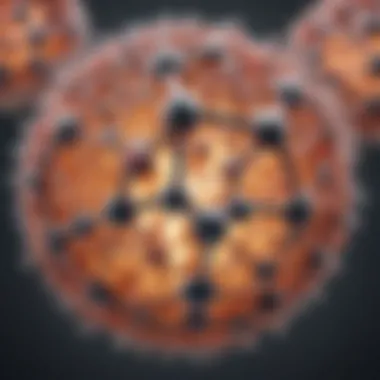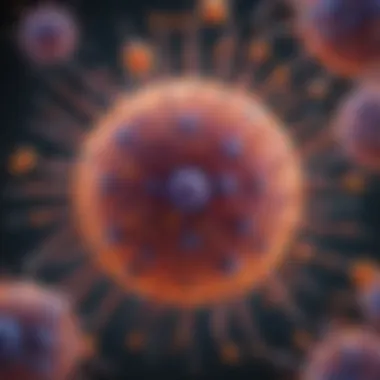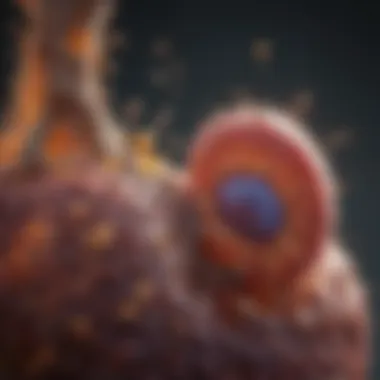Exploring the Role of Human Thioredoxin in Health


Intro
Human thioredoxin is a fascinating protein that plays a pivotal role within the realm of redox biology. This article delves into its structural characteristics and functional dynamics, while also tackling its implications across various health contexts. From its importance in maintaining cellular homeostasis to its potential therapeutic applications, thioredoxin's relevance cannot be overstated. By unpacking recent research, we aim to shed light on how this protein influences both normal physiological processes and disease states.
Prelims to Human Thioredoxin
The importance of human thioredoxin cannot be overstated. This small but potent protein is fundamental to numerous biological processes. It serves as a crucial player in maintaining redox balance within cells. Thus, understanding thioredoxin is essential for advancements in many fields, including biochemistry, medicine, and therapeutic research. In this section, we will explore key elements and considerations that underscore the relevance of thioredoxin in biological and health contexts.
Overview of Thioredoxin
Thioredoxin is a 12 kDa protein characterized as a redox-active molecule. It has two central features: a conserved dithiol active site and the ability to undergo reversible oxidation and reduction. These properties enable thioredoxin to facilitate electron transfer in various biochemical reactions, particularly those associated with maintaining cellular redox states.
Thioredoxin exists in many forms across different organisms. However, the human thioredoxin is particularly significant due to its involvement in cellular signaling and defense against oxidative stress. This multifaceted role spans various functions, from protecting cells against damage caused by reactive oxygen species to regulating pivotal cellular processes, such as apoptosis and cell proliferation.
Historical Context and Discovery
The journey of thioredoxin’s discovery began in the early 1960s. Initially, thioredoxin was recognized as a factor necessary for the reduction of ribonucleotide reductase, an enzyme critical for DNA synthesis. The term "thioredoxin" was coined in 1964, and since then, extensive research has unveiled its diverse functions.
Important milestones in the understanding of thioredoxin include the exploration of its structural characteristics in the late 1980s. Researchers began to map its three-dimensional structure, revealing the precise mechanisms by which this protein exerts its effects at the molecular level.
As scientific investigation progressed, the focus shifted toward the implications of thioredoxin in health and disease, providing insight into its therapeutic potential. From its intriguing history to its current significance in modern research, thioredoxin remains a pivotal subject, bridging molecular biology and clinical medicine.
Structural Characteristics of Human Thioredoxin
The structural characteristics of human thioredoxin play a fundamental role in understanding its biological functions and implications in health and disease. Thioredoxin is not merely a passive player in cellular systems; rather, its intricate structure directly influences its redox activity and interactions with other biomolecules. By delving into the specifics of its molecular composition, three-dimensional structure, and active sites, one gains clearer insight into how thioredoxin participates in essential biological processes.
Molecular Composition
Human thioredoxin is a small protein, typically comprising around 100 amino acids. Its primary amino acid sequence varies somewhat among different organisms, yet its basic functional aspects are conserved across species. This conservation hints at the importance of its sequence in maintaining structural integrity and functional efficacy. Thioredoxin's molecular composition includes key residues that play a crucial role in electron transfer during redox reactions.
Some essential motifs are:
- Cysteine residues, which are often found in pairs, critical for its redox activity.
- A compact and stable structure, usually formed by alpha-helices and beta-sheets, allows the protein to maintain functionality under various cellular conditions.
- Hydrophobic and polar regions that facilitate its interaction with other proteins and substrates.
Understanding this composition helps researchers determine how small changes might affect thioredoxin's roles in various physiological conditions.
Three-dimensional Structure
The three-dimensional structure of thioredoxin is paramount to its functions. Recent advancements in X-ray crystallography and nuclear magnetic resonance (NMR) imaging have revealed a well-defined structure with a thioredoxin fold, characterized by a central core formed from beta-sheets surrounded by alpha-helices. This architecture provides necessary stability while allowing for conformational flexibility, essential for its interactions.
Through analysis of its structure, one can attribute several functions to thioredoxin:
- The open conformation can accommodate diverse substrates, enhancing its role as a redox agent.
- It can bind to various proteins, acting as a chaperone, thereby assisting in protein folding processes.
- The precise arrangement of its active site is vital for effective electron transfer, crucial for its functional dynamics.
Redox Active Sites


The redox active sites of thioredoxin consist primarily of two cysteine residues that form a disulfide bond. This bond acts as a redox switch, enabling thioredoxin to accept and donate electrons. These cysteine pairs are often referred to as the active redox couple. Their local environment, including surrounding amino acids, influences the redox potential.
In practical terms, the presence of the redox active sites indicates:
- A capacity for thioredoxin to reduce oxidized proteins, thus restoring their function.
- Participation in detoxifying reactive oxygen species, hence its role in cellular antioxidant defenses.
- Modulation of apoptotic pathways through redox signaling, indicating its significance in health and disease contexts.
"The redox active sites in thioredoxin are crucial for its functionality, highlighting its role in maintaining redox balance in cells."
By comprehending these structural features, it becomes evident how thioredoxin influences cellular processes and how alterations in these characteristics may correlate with various pathologies.
Functional Dynamics of Thioredoxin
The exploration of thioredoxin's functional dynamics is crucial in understanding its multifaceted roles in cellular processes. Thioredoxin, a small redox-active protein, is not just involved in maintaining the redox balance within cells; it also plays pivotal roles in various biochemical interactions that influence cellular health and disease progression. By examining its functions, including its contributions to redox reactions and interactions with other biomolecules, we can uncover the underlying mechanisms that make thioredoxin indispensable in cellular biology. This section outlines these functional dynamics and their implications in health.
Role in Redox Reactions
Thioredoxin serves as a key player in redox reactions, acting primarily as an electron donor. It contributes to the reduction of disulfide bonds in proteins, facilitating their activation and proper folding. This function is essential because many cellular proteins require a reduced environment to maintain their activity. Here are some important aspects:
- Electron Donation: Thioredoxin donates electrons to protein disulfides, thereby reducing them and restoring their active forms.
- Regulatory Function: By modulating the redox state of various cellular proteins, thioredoxin influences several signaling pathways. This includes the activation of transcription factors like NF-kB, which plays a role in inflammation and immune response.
- Protection Against Oxidative Stress: Thioredoxin mitigates the effects of oxidative stress, a condition associated with aging and various diseases. It increases the resilience of cells to oxidative damage by maintaining thiol groups in their reduced state.
The ability of thioredoxin to engage in these reactions underscores its role in sustaining cellular functions and protecting against detrimental impacts caused by oxidative species.
Interaction with Other Cellular Biomolecules
The interaction of thioredoxin with other cellular biomolecules emphasizes its integrative function in cell biology. Thioredoxin does not work in isolation; its activity affects and is affected by a range of proteins and enzymes. Key points regarding these interactions include:
- Thioredoxin and Thioredoxin Reductase: Thioredoxin interacts with thioredoxin reductase to maintain its reduced state. This enzyme facilitates the recycling of oxidized thioredoxin, connecting the redox dynamics within the cell.
- Regulation of Target Proteins: Thioredoxin can form complexes with various target proteins, affecting their function and modulation. This interaction can lead to changes in cellular metabolism and signaling.
- Collaboration with Antioxidant Systems: In the broader context of antioxidant defenses, thioredoxin functions alongside other systems, such as glutathione, to provide a robust response to oxidative stress.
"The importance of thioredoxin in these interactions cannot be overstated, as it forms a nexus of cellular redox regulation and influences a wide array of biological processes."
Through these interactions, thioredoxin plays a vital role in overseeing cellular homeostasis, making it a focus of interest for researchers seeking to understand its broader implications in health and disease.
Thioredoxin and Cellular Homeostasis
Human thioredoxin plays an essential role in maintaining cellular homeostasis. This vital protein is involved in crucial biological processes and ensures the proper functioning of various cellular mechanisms. The regulation of cellular environments is intricate, influenced by multiple factors, including oxidative stress, enzyme activities, and reaction dynamics. By modulating the redox state within cells, thioredoxin supports various metabolic pathways and protects cells from damage.
Antioxidant Defense Mechanisms
Thioredoxin functions as a powerful antioxidant. It mitigates oxidative stress by directly reducing reactive oxygen species (ROS). These harmful compounds can cause cellular damage, leading to diseases. Thioredoxin, through its redox-active properties, helps neutralize these reactive molecules, thereby preventing oxidative damage to proteins, lipids, and DNA.
In addition, thioredoxin can regenerate other antioxidants, such as vitamin C and glutathione. This recycling process extends the protective capabilities of these molecules, ensuring prolonged antioxidant defense.
- Reduced thioredoxin: Acts directly on ROS.
- Regeneration of antioxidants: Extends their protective effect.
This multi-faceted antioxidant action highlights the importance of thioredoxin in sustaining redox balance, crucial for cellular health.


Regulation of Protein Function
Thioredoxin plays a pivotal role in the regulation of protein function. Many proteins undergo structural and functional changes based on their redox state. Thioredoxin can reduce disulfide bonds, which are often formed under oxidative conditions. When these bonds are reduced, proteins can regain their active conformation.
This mechanism is particularly significant in enzymes that rely on thiol groups for activity. Thioredoxin serves as a crucial modulator, thereby influencing the activity of various proteins in response to oxidative signals.
Through its interaction with proteins, thioredoxin impacts numerous pathways, including those related to metabolism and cell signaling.
"Thioredoxin's influence extends well beyond its antioxidant capabilities; it bridges the gap between oxidative stress management and protein functionality."
Understanding the dual role of thioredoxin as both an antioxidant and a regulator of protein function provides insight into its significance in sustaining cellular homeostasis. This interplay is critical in maintaining a stable internal environment conducive to optimal biological performance.
Pathophysiological Implications of Thioredoxin
Thioredoxin is increasingly recognized for its pivotal role in various pathophysiological processes. Its functions extend beyond regular cellular upkeep to significant influence in disease states. Understanding thioredoxin's implications in these conditions is crucial, as it opens potential pathways for therapeutic interventions. This section delves into how thioredoxin relates to oxidative stress and links to specific diseases, highlighting its multifaceted role in human health.
Role in Oxidative Stress
Oxidative stress arises when there is an imbalance between free radicals and antioxidants in the body. Thioredoxin plays a protective role by acting as a powerful antioxidant. It directly reduces oxidative stress by detoxifying reactive oxygen species. By doing so, thioredoxin helps to preserve cellular integrity and function. A deficiency in thioredoxin can lead to increased oxidative stress, thereby contributing to a variety of ailments.
Research shows that elevated oxidative stress is linked to many chronic conditions, including diabetes, hypertension, and inflammatory diseases. By modulating oxidative stress, thioredoxin can mitigate these health risks. Thus, maintaining stable thioredoxin levels may offer a preventive strategy against oxidative stress-related diseases.
Association with Diseases
The implications of thioredoxin extend into numerous disease categories.
Cardiovascular Diseases
Cardiovascular diseases represent a leading cause of mortality globally. Thioredoxin is vital due to its role in reducing oxidative stress, which is a known contributor to cardiovascular issues. Evidence suggests that low thioredoxin levels correlate with increased risk of heart disease. Thioredoxin’s ability to protect vascular endothelial cells from damage is particularly noteworthy. Enhancements in thioredoxin activity could serve as a protective mechanism, making it crucial for cardiovascular health. This connection establishes thioredoxin as a significant player in the management of cardiovascular diseases.
Neurodegenerative Disorders
Neurodegenerative disorders, such as Alzheimer’s and Parkinson’s diseases, exhibit a clear relationship with oxidative stress. Thioredoxin helps to stabilize protein conformation and protect neuronal health. Deficits in thioredoxin can exacerbate neuronal damage and lead to accelerated progression of these disorders. Its neuroprotective effects can be viewed as a potential therapeutic avenue. Therefore, understanding thioredoxin's role in neurodegenerative conditions is essential for developing strategies targeting these complex diseases.
Cancer
The role of thioredoxin in cancer is intricate. Cancer cells often exploit elevated levels of oxidative stress to promote their growth. Thioredoxin facilitates this environment by maintaining redox balance. However, its upregulation in tumor cells can also offer therapeutic targets. Inhibiting thioredoxin activity may induce apoptosis in cancer cells, thereby reducing tumor growth. This dual role presents both challenges and opportunities in cancer treatment, highlighting the importance of thioredoxin in cancer biology.
Thioredoxin's multifaceted role in disease makes it a significant focus for therapeutic research.
In summary, the pathophysiological implications of thioredoxin reflect its central role in health and disease management. Understanding how it interacts with oxidative stress and various diseases offers pivotal insights into developing effective therapies. This raises the importance of further exploration into thioredoxin modulation as a promising strategy to enhance health outcomes.
Emerging Research on Thioredoxin
Emerging research on thioredoxin reflects a growing recognition of its critical role in various biological processes. Understanding the nuances of thioredoxin can significantly enhance our knowledge of cellular mechanisms and potential therapeutic applications. The advancements in this field are important for both basic science and clinical contexts, as they pave the way for novel interventions and treatments. Increased research focus on this protein has revealed new insights into its function and implicated its modulation in health preservation.


Recent Advances
Recent studies have made significant strides in elucidating the roles and mechanisms of thioredoxin. Notably, researchers have discovered novel variants of thioredoxin and their unique properties. These variants may play different roles in redox reactions and stress response, which adds a layer of complexity to our understanding of thioredoxin biology. Furthermore, innovative techniques in proteomics and genomics have enabled scientists to explore thioredoxin interactions at an unprecedented scale. This has led to the identification of new pathways that thioredoxin influences, especially in the context of oxidative stress response and cellular signaling.
Another important area of recent research includes the exploration of thioredoxin as a potential biomarker for various diseases. Studies have suggested that altered levels of thioredoxin may correlate with the progression of certain conditions, like cancer and cardiovascular diseases. Recognizing its diagnostic potential could lead to earlier detection and monitoring of these ailments.
Future Directions
Looking ahead, several future directions in thioredoxin research appear promising. One critical area is the development of thioredoxin-based therapeutics. Given the protein's involvement in numerous disease mechanisms, fine-tuning its modulation could offer new treatment strategies. Researchers are exploring various compounds, including small molecules, that can enhance or inhibit thioredoxin activity. This could open up avenues for selective therapies, particularly for diseases characterized by oxidative stress.
Another potential focus will be the elucidation of the networks surrounding thioredoxin. Determining how thioredoxin interacts with other redox-sensitive proteins can deepen our understanding of its broader impact in cellular physiology. Additionally, the integration of advanced imaging techniques could provide insights into thioredoxin dynamics in live cells, thus informing on its real-time function during stress conditions.
Therapeutic Potential of Thioredoxin Modulation
Thioredoxin modulation presents a significant area of interest within biomedical research. This is largely due to thioredoxin's multifaceted roles in redox signaling and cellular defense mechanisms. Modulating thioredoxin levels could unlock new therapeutic avenues for various diseases linked to oxidative stress. Understanding this potential necessitates a close examination of drug development strategies and clinical considerations surrounding thioredoxin.
Drug Development Strategies
The design of drugs that target thioredoxin involves several strategies. Here are some approaches currently being explored:
- Direct Thioredoxin Activators: Compounds that enhance thioredoxin activity can be developed to improve antioxidant defenses. For example, small molecules or peptides may activate thioredoxin's function in cells already under oxidative stress.
- Thioredoxin Inhibitors: In certain diseases, reducing thioredoxin levels may be beneficial. In cancer treatments, since thioredoxin can contribute to tumor resilience against oxidative stress, inhibitors are being researched to sensitize cancer cells to therapy.
- Gene Therapy Techniques: Utilizing gene editing tools like CRISPR to modulate thioredoxin expression has gained traction. This approach could allow for precise alterations in thioredoxin levels, potentially leading to improved therapeutic outcomes.
- Nanoparticle-Delivery Systems: Some novel approaches utilize nanoparticles to deliver thioredoxin-modifying agents directly to target tissues. This can enhance the efficacy and bioavailability of therapeutic agents while minimizing systemic side effects.
Developing these strategies demands detailed knowledge of thioredoxin’s structure and function as well as comprehensive testing for effectiveness and safety.
Clinical Considerations
As research accelerates, the clinical implications of thioredoxin modulation must be carefully evaluated. Key considerations include:
- Patient Variability: Individual responses to thioredoxin-modulating therapies may vary significantly. Factors such as genetics, existing health conditions, and concurrent medications can influence efficacy.
- Toxicity and Safety: Any therapeutic approach aiming to alter thioredoxin levels must substantiate a favorable safety profile. Potential side effects or toxicity must be assessed in preclinical and clinical trials.
- Therapeutic Window: Identifying an effective and safe dosage that can result in the desired biological effect without adverse effects is crucial.
- Long-term Outcomes: The impact on long-term health when modulating thioredoxin is still not fully understood. Ongoing studies should strive to clarify the chronic effects of such treatments.
- Integration with Other Therapies: The possibility of combining thioredoxin modulation with established treatments is an area of significant interest. Understanding synergistic effects is essential for comprehensive treatment planning.
Thioredoxin’s therapeutic potential is profound. As the understanding of its biological roles expands, so does the scope for therapeutic applications. This could revolutionize treatment protocols for a variety of diseases, enhancing patient outcomes in clinical settings.
"Understanding thioredoxin modulation offers a promising avenue in disease treatment, bridging the gap between redox biology and modern medicine."
The landscape for thioredoxin-based therapies continues to evolve, warranting further research and clinical inquiry to harness its full potential in patient care.
The End
The inclusion of thioredoxin as a focal point in this article underscores its critical role in redox biology and cellular functions. We have explored the intricate structure and unique biochemical functions that position thioredoxin as a significant player in maintaining cellular homeostasis. Understanding these elements is essential not just for basic science but also for their far-reaching implications in health and disease management.
Summary of Key Points
In summarizing the key points discussed, several critical aspects emerge:
- Structural Features: Human thioredoxin exhibits a compact structure comprising active sites crucial for its redox functions.
- Functional Roles: It serves multiple functions in the cell, acting in the regulation of stress responses and protein functions.
- Pathophysiological Impact: Thioredoxin is implicated in various disease states including cancer, cardiovascular diseases, and neurodegenerative disorders, highlighting its relevance for therapeutic strategies.
- Therapeutic Potential: The modulation of thioredoxin offers promising avenues for drug development, emphasizing its role in clinical interventions and health improvements.
Implications for Future Research
Looking ahead, future research on thioredoxin should focus on several key areas:
- Mechanistic Insights: There is a need for deeper mechanistic understanding of how thioredoxin interacts with other cellular components during oxidative stress.
- Therapeutic Applications: Investigating drug delivery systems that can effectively target thioredoxin modulation could lead to breakthroughs in treating diseases where thioredoxin plays a pivotal role.
- Clinical Trials: Encouraging clinical trials that explore thioredoxin as a biomarker for disease severity could enhance our diagnostic capabilities in pathology.
- Biotechnological Innovations: Further advancements in biotechnology may uncover novel thioredoxin-based therapeutics, improving health outcomes in various conditions.
By reinforcing the relevance of thioredoxin within the fields of health and disease, this article aims to stimulate interest and direct future research efforts. A collective push toward unearthing its full potential will be vital as we navigate the complexities of human health.



